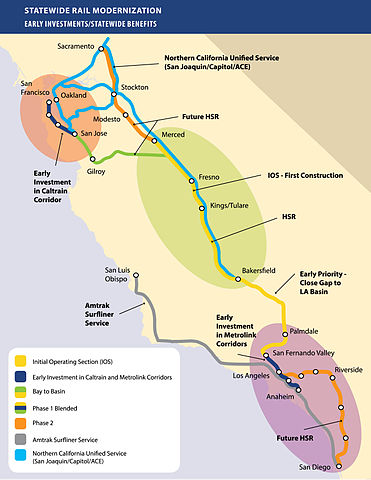One could argue a proposed regional passenger-rail service between the South San Joaquin Valley community of Porterville and Huron located in southwestern Fresno County, for all intents and purposes running alongside California State Route 198 or SR 198 (see: “Valley could get regional passenger rail: Tulare County Association of Governments has plan” Air Quality Matters blogpost here) with a proposed combined Kings/Tulare regional station stop situated about halfway in between to provide a connection with and service to future high-speed trains, if instituted, would be advantageous. (This proposed line is referred to as the Central Valley Corridor or CVC). But I would first ask: Advantageous in regards to what or to whom?

Downtown revitalization and local economy stimulation in the identified CVC-based communities proposed to be served, here again, both would as well be advantageous, providing, of course, that the passenger train as proposed and if instituted, were to capture enough market share to justify its existence. But, these are all very big ifs.
And, speaking of SR 198 and of one other – in this case Interstate 580 (somewhat farther to the north in the Valley; and each principally on an east-west tangent or trajectory), they both meet up with SR 101 – the former connecting SR 65 near Exeter with 101 just north of San Lucas; the latter bridging Interstate 5 near Tracy with 101 in San Rafael in the North San Francisco Bay Area.
What’s more, what the two routes also have in common is that both parallel active railroad lines. A considerable portion of 198 is in close proximity and parallel to the CVC which, incidentally, is a relatively lightly used freight line owned by the San Joaquin Valley Railroad. On the other hand, almost all of 580 is paralleled by lines owned by the Union Pacific (at least as far as Richmond in the northern Bay Area) as well as by the Bay Area Rapid Transit (BART) heavy-rail passenger service (between Richmond and Dublin).
Besides that pointed out above and 198 being a state highway and 580 being an interstate highway, the two thoroughfares could not be more different.
While I have traveled each route – 580 extensively and portions of 198 only occasionally – and while the former at times resembles a parking lot, the latter in that regard can’t compare. State Route 198 is essentially an open road at all times, day and night.
So, with this in mind, I have a difficult time wrapping my head around why the Tulare County Association of Governments is looking into the possibility of instituting passenger train service on the CVC. What am I missing?
Conversely, in the Valley to the north, what with I-580 heavily traveled, that the Altamont Corridor Express (ACE) offers Monday through Friday passenger rail service in both the morning and late afternoon time slots which roughly parallels the motorway (the Tracy to Pleasanton part), even with this, other proposals have been floated to add even more passenger rail capacity.
In “On air-cleanup matters, the North has thing or two to offer South, Central Valley,” I wrote: “Along these lines, there is now a promising effort underway to connect the Bay Area Rapid Transit (BART) heavy rail commuter rail network at the Dublin/Pleasanton station to a station in the northern San Joaquin Valley via a light rail transit system. The idea here is to get motorists out of their cars and onto public transportation to provide further relief to the extremely heavy traffic that seems to have overwhelmed portions of Interstate 580, a main highway artery between the Valley and the east Bay Area” [editor’s note: north Bay Area, actually]. Such a service could be just the ticket to make I-580 less parking-lot-like and possess more the “open-roadish” characteristic that 198 has to its south.
Add to this the serious talk of extending BART from the Dublin/Pleasanton station (where the service presently terminates) east to the town of Livermore, if not one day beyond, which rounds out such discussion.
Important to note is that while ACE trains share rails with Union Pacific freights, a light rail service between Dublin/Pleasanton and say Tracy or Stockton would not, that is, would not share rails with freights, similar in principle to eBART for 10 miles between Pittsburg/Bay Point and Antioch.
And while unsure of the prospects of economy boosting and efforts aimed at furthering downtown revitalization around stations in served communities, what I am certain of is that more regional passenger rail service, in the right location under the right sets of conditions and/or circumstances, is very effective at enticing affected corresponding drivers out of private personal passenger vehicles, which, not only can help take traffic off area roads and freeways but, by extension, can help remove much of the pressure on the air in the region affected by eliminating or alleviating toxic chemicals in it.
One last observation: Before any passenger trains ever roll along the CVC, whether this be 10, 20 or 30 years from now, whomever owns the rail infrastructure, the owner(s) would have to give their blessing first.
Image above: California High-Speed Rail Authority
– Alan Kandel